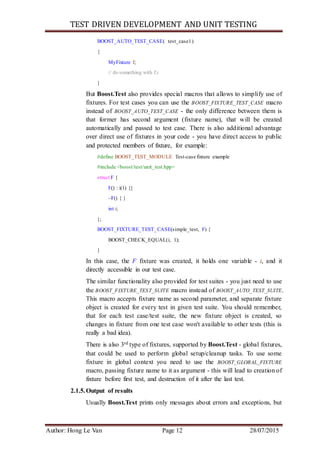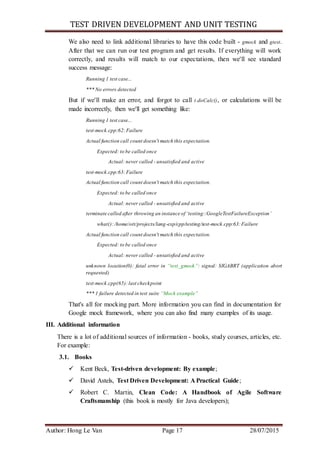Test-driven development (TDD) relies on short development cycles of writing a failing test case, producing code to pass that test, and refactoring the code. Unit testing tests individual units of code by isolating each part and showing they work correctly. Boost.Test is a popular C++ unit testing framework that allows organizing tests into suites and fixtures, and provides assertions and output of results. A minimal Boost.Test example defines a test case using BOOST_AUTO_TEST_CASE that contains an assertion like BOOST_CHECK_EQUAL to test that 2+2 equals 4.
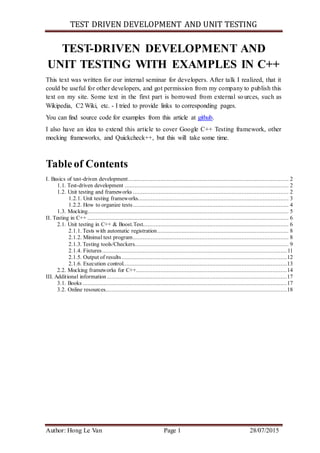



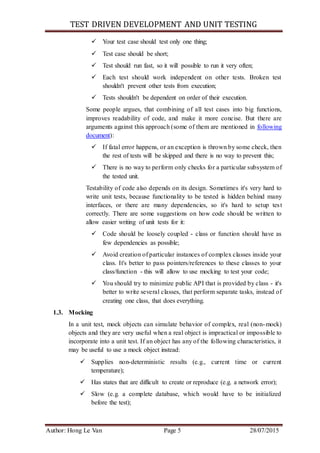

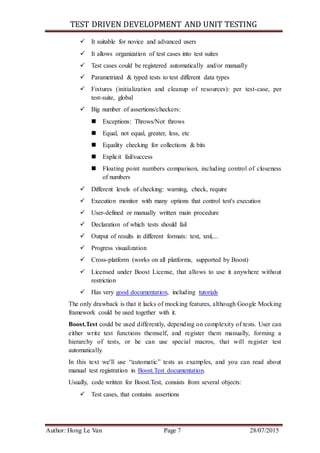
![TEST DRIVEN DEVELOPMENT AND UNIT TESTING
Author: Hong Le Van Page 8 28/07/2015
Test suites, that combines several test cases into bigger object
Fixtures, that are used to perform setup and cleanup of resources/data for
test cases, test suites and/or global context.
Tests are executed by Execution monitor that controls execution of tests, handles
errors, and collects data about executed/failed tests. Developer may control
behaviour of execution monitor through command-line options, environment
variables, or from source code.
2.1.1.Tests with automatic registration
For simple tests the use of Boost.Test is straightforward - you include
necessary header files, and write test cases (possibly, organizing them into
test suites), compile your test, and link it with the
boost_unit_test_framework library (it contains the main function that will
perform setup of tests, and their execution).
2.1.2.Minimal test program
Here is minimal example, that defines one test:
#define BOOST_TEST_MODULE Simple testcases
#include <boost/test/unit_test.hpp>
BOOST_AUTO_TEST_CASE(simple_test) {
BOOST_CHECK_EQUAL(2+2, 4);
}
First line declares name of this test, second line includes necessary header
file, and lines 4-6 define test - the BOOST_AUTO_TEST_CASE macro is used
to define test with given name (simple_test), and test's body contains one
assertion: 2+2 == 4 - this assertion uses BOOST_CHECK_EQUAL macro to
perform check.
After compilation you can run this program, and it will print following on
the screen (Boost.Test can also output results in different formats, and you
can also control verbosity of output with execution monitor's options - see
below):
Running 1 test case...
*** No errors detected
If something will go wrong, then framework will print another message on
the screen:
Running 1 test case...
test-simple.cpp(5):error in “simple_test”: check 2+2 == 5 failed [4 != 5]
*** 1 failure detected in test suite “Simple testcases”
This information includes number of failures in given test program (called](https://image.slidesharecdn.com/testdrivendevelopmentandunittestingwithexamplesinc-151124095632-lva1-app6891/85/Test-driven-development-and-unit-testing-with-examples-in-C-8-320.jpg)

![TEST DRIVEN DEVELOPMENT AND UNIT TESTING
Author: Hong Le Van Page 10 28/07/2015
created.
In basic form, the checker is a macro in form BOOST_<level>[_check] that
receives one or more arguments. The only exceptions from this rule are
BOOST_ERROR and BOOST_FAIL macros, that are used to produce explicit
errors (normal and fatal). Complete list of checkers you can find in
reference.
Basic macros (BOOST_WARN, BOOST_CHECK, and BOOST_REQUIRE) accept
only one argument - expression to check, like following:
BOOST_WARN( sizeof(int) == sizeof(short) );
BOOST_CHECK( i == 1 );
BOOST_REQUIRE( i > 5 );
If check will fail, then Boost.Test will report line in source code where this
happened, and what condition was specified. You can also provide your
own message to output using BOOST_<level>_MESSAGE macros.
But when you compare something, then it's better to use specialized
macros, like BOOST_<level>_EQUAL, BOOST_<level>_NE, BOOST_<level>_GT,
etc. The main advantage of these macros, is that they will show you both
expected, and actual value, instead of simple message that comparison was
failed (this functionality could be also used for your own predicates, if
you'll use BOOST_<level>_PREDICATE macros). For example, look onto
following code:
int i = 2;
int j = 1;
BOOST_CHECK( i == j );
BOOST_CHECK_EQUAL( i, j );
the first checker will only report that check was failed:
test.cpp(4):errorin “test”: check i == j failed
while the second checker, will report about problem, together with actual
values, used in comparison:
test.cpp(5):errorin “test”: check i == j failed [2 != 1]
Boost.Test also provides specialized checkers for comparison of
collections (BOOST_<level>_EQUAL_COLLECTION), and bitwise comparison
(BOOST_<level>_BITWISE_EQUAL).
Comparison of floating-point numbers with standard comparison operators
isn't a good idea (because of precision), but Boost.Test provides several
macros that solve this task (you need to include additional header file to
use them: boost/test/floating_point_comparison.hpp): BOOST_<level>_CLOSE,
BOOST_<level>_CLOSE_FRACTION, and BOOST_<level>_SMALL.](https://image.slidesharecdn.com/testdrivendevelopmentandunittestingwithexamplesinc-151124095632-lva1-app6891/85/Test-driven-development-and-unit-testing-with-examples-in-C-10-320.jpg)

